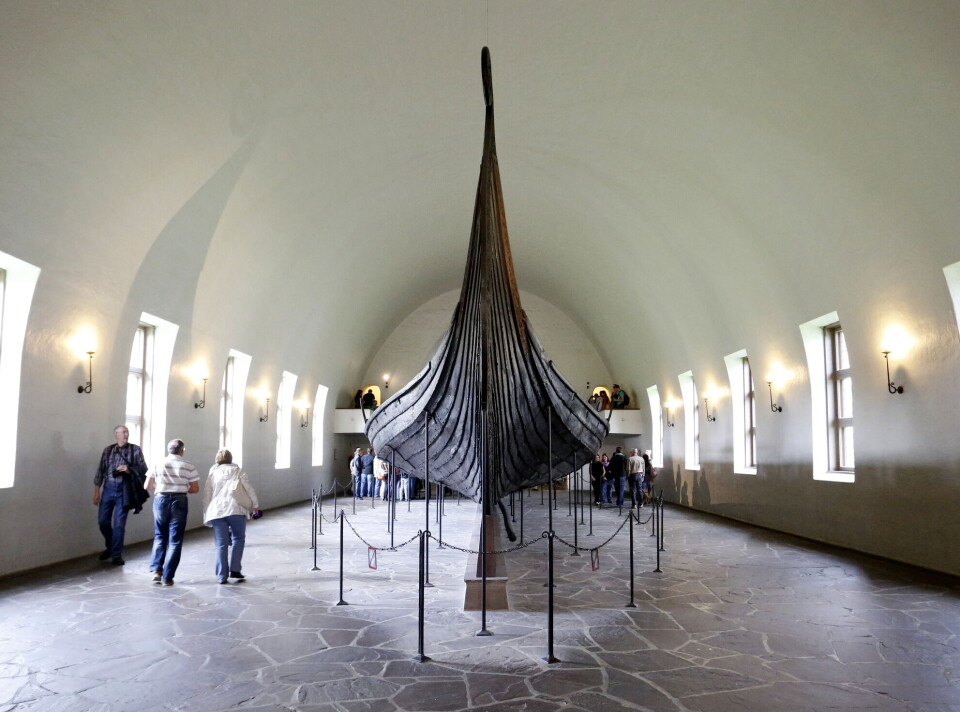
We need ambitions for an iconic Viking Age Museum
OPINION: A modern museum must secure the collection, but also facilitate dissemination and research.
The squandering of our most iconic cultural heritage by the red-green government is hardly believable, the newspaper Dagens Næringsliv wrote in an editorial (link in Norwegian). They called it an absurd Viking raid. I agree. A long and continuous ‘history of suffering’ is being dragged out.
The story started back in the 1880s. In 2027, we will have a new building, but it will be a stripped building that does not properly serve our aims of an iconic Museum of the Viking Age. The final word has not been spoken on this.
Recent history
It is almost 5 years since the Solberg government gave the go-ahead for the new Viking Age Museum. For more than a hundred years, various governments had pushed the responsibility for the Viking ships ahead of them, but now the Solberg government’s Granavolden Declaration had set a new course.
The jubilation did not last long.
In May 2022, the Støre government decided that the building costs for the new museum had to be reduced by NOK one billion (approximately 93 million USD). We fought this, and in June, the decision was partially reversed. The cut ended up at 'only' 300 million (28 million USD). We celebrated moderately.
The director of the Museum of Cultural History, Aud Tønnessen, recently drew renewed attention to what these short-term motivated cuts entail in an op-ed in Aftenposten on Jul7 3 (link in Norwegian).
The consequences are significant
A modern museum requires facilities beyond what secures the objects themselves. It is about dissemination – and at a university museum, it is about being able to carry out continuous research.
New findings and modern technologies provide new insights and continuously develop our understanding. We need ambitions for an iconic museum in constant development.
In her op-ed, Tønnessen writes: 'Crucial functions such as exhibition rooms and activities for school children are not completed, nor are outdoor park areas with playgrounds and a café. Lecture halls and laboratories where the public can meet our research are delivered as just outer structures. The restaurant area is delivered without a production kitchen. There are no offices or facilities for employees, and technical solutions are reduced. In sum, everything that has been removed will lower the overall experience for Norwegian and foreign visitors, and the museum’s operating situation will be unsatisfactory.'
So the struggle continues to create a museum that our most important cultural heritage deserves; a museum that the Norwegian population and guests from all over the world deserve.
The exact price for the parts of the building that were cut and which the government expects the University of Oslo to finance privately is now, of course, much higher than the 250-300 million that were originally cut. We may need to multiply the cost by three, and that number increases continually.
It all started in the 1880s
Ever since the 1880s, the Storting has been urged to finance a new museum for the University of Oslo’s important cultural history collections. In 1898, the Storting reluctantly agreed – on the condition that the building would not house the Viking ships from Tune and Gokstad, which at the time were exhibited in sheds in the University Garden.
When the Historical Museum was completed at Tullinløkka in 1904, the building was already severely undersized.
The issue was not improved by the discovery of the Oseberg Ship that same year. This ship was brought to Oslo with the help of generous private donations – the state was not able to cover the costs.
The ship was stored in a simple corrugated iron shed. The thousand-year-old ship planks soon showed clear signs of damage due to the poor storage conditions. Aftenposten even published 'fake news' in 1906 and claimed that the ships had burned down overnight to draw attention to the irresponsible handling of the ships.
For the University’s Collection of National Antiquities, to which the Viking ships belong, the situation was completely indefensible. The collection’s curator, Gabriel Gustafson, worked intensively to secure a satisfactory museum building for the three Viking ships.
After several years of investigations, it was decided in 1913 that a new museum building should be built at Bygdøy, a peninsula to the west of the capital Oslo. A plot was purchased, large enough to house an entire national museum.
In 1914, the newly established architect Arnstein Arneberg won the architectural competition with the sketch Osebergdronningen (the Oseberg queen), the first draft of today’s Viking Ship Museum.
Initial funding in 1916
The curator of the Collection of National Antiquities, Gabriel Gustafson, led the process up to the completed architectural competition. He died in 1915 and therefore never saw the plans realised. It was his successor, Anton Wilhelm Brøgger, who took over the project.
Brøgger faced a difficult task, although it started well: In 1916, the initial funding was secured in the National Budget. By the following year, the money had run out. The funding had only financed foundation work for three of the four planned wings.
After several years of intensive lobbying from Brøgger, the Storting allocated enough funds for building the hall housing the Oseberg Ship in 1926. That same year, the ship was brought into the hall after a spectacular journey through the city on railway tracks and barges.
Then everything came to a halt. It was impossible to secure a parliamentary grant to continue the work.
Royal Resolution with strong reservations in 1927
In 1927, funds were made available by Royal Resolution from funds related to coal power production during World War I. This was far from enough, though. Brøgger had to mobilise his entire network to raise money privately so that the wings housing the Tune Ship and the Gokstad Ship, as well as the central tower, could be erected.
The fundraising did not cover all expenses, and so Brøgger took out loans secured by his own salary to complete the tower. We can see evidence of the lack of funds even today: The observant visitor will notice that the inside of the tower appears to be solid masonry, but it is actually built of wood plastered with cement.
The Royal Resolution was most appreciated, but it was also conditional. The funds were granted with the clause that financing the completion of the Viking Ship Museum was not the public’s concern. The state did not want to spend more money on securing the iconic Viking ships.
Nevertheless, the University of Oslo and the Collection of National Antiquities could celebrate the opening of the two new wings in 1932, thanks to Brøgger’s tireless efforts.
Subsequent governments kept their word. Although the University of Oslo repeatedly asked for funds to complete the building, with a fourth wing that could house the findings from Gokstad and Oseberg, the Storting systematically rejected the applications. Brøgger died in 1951 with the matter unresolved.
Selling of bonds in 1957
Brøgger’s death must have shocked the university leadership, for shortly thereafter they decided to sell bonds to erect the fourth wing. The wing was completed in 1957, and the magnificent objects from the Oseberg grave could finally be displayed.
The opening sparked Viking fever among Norwegian artists, designers, and cultural enthusiasts, inspired by the Viking Age's aesthetic in the following decade. Few noticed that the hall was built in the simplest way and far below the standard for sustainable museum buildings.
60 years later, the overly simple solutions threaten to destroy the exhibited objects.
Built for 40,000 visitors
It had taken 70 years to house the Viking ships. Perhaps both the parliamentary politicians and the University of Oslo thought the matter was resolved. Not so. The Viking ships have world heritage status and will always be of great interest to the public. Visitor numbers have steadily increased since the 1950s.
Arneberg envisioned about 40,000 visitors a year. Before the museum was closed for renovation in 2021, more than 550,000 people visited annually. The capacity was long since exceeded, which put the ships, the building, and the visitors to the test.
The support systems for the ship hulls, developed in the early 1900s, were far from good enough. They could not be improved as long as the ships stood in the old museum.
A new building became a prerequisite for safeguarding the Viking ships for the future. The situation was not so different from what Aftenposten described in 1906: Without a new building, the safety of the ships constituted an ever growing challenge. The fight for a new museum continued and was both intense and demanding.
Official study in 2014
In 2014, the Solberg government ordered an official study into a new museum building for the Viking ships at Bygdøy. In 2018, the planning was completed, and the government received a quality-assured project for a new building extending from the old one – a project that was applauded by both laypeople and experts.
The efforts to secure funding were intensified, and editors in newspapers across Norway engaged in the fight. Although the Viking Ship Museum is managed by the University of Oslo, the ships are, of course, our shared national heritage.
As such, 'all of Norway' applauded when the initial funding was announced on the university's 208th anniversary.
Goal: an iconic Viking Age Museum
We should be glad that the new Viking Age Museum is now emerging at Bygdøy.
State Secretary Ivar B. Prestbakmo emphasises in his answer to the critical DN editorial that the safety of the collection is the project’s most important goal. He is, of course, absolutely right.
The University of Oslo has fought tooth and nail since the 1880s to secure the ships and artefacts a 'good and safe home.' And in many ways, it will be a functional building. It will secure the fragile Viking treasures for the future.
However, it is hard to believe that the cut of NOK 250-300 million in 2022 was based on a socioeconomic analysis. The cut significantly degrades the museum and dramatically reduces the opportunities for dissemination and learning.
We will not get the iconic, research-based Viking Age Museum that was planned. I believe this is a loss both economically and to Norway as a cultural nation. The long ‘history of suffering’ continues. The final word has not been spoken on this.
Share your science or have an opinion in the Researchers' zone
The ScienceNorway Researchers' zone consists of opinions, blogs and popular science pieces written by researchers and scientists from or based in Norway. Want to contribute? Send us an email!




























